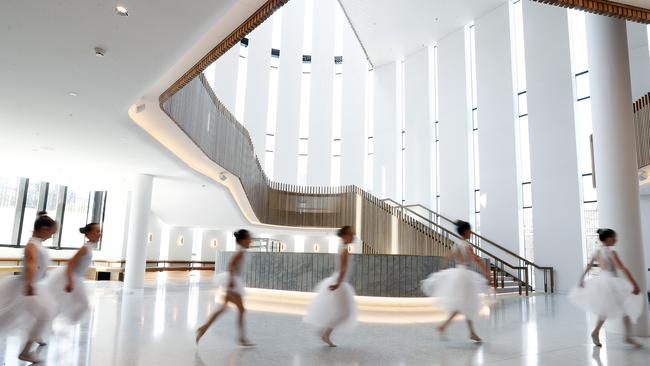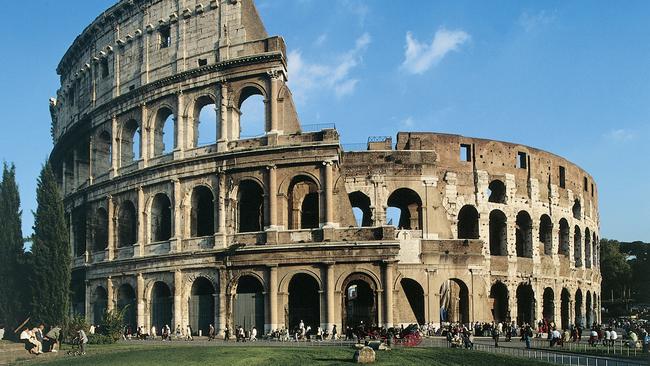Ancient history behind Western Sydney’s ‘epic’ Coliseum theatre
Sydney has a brand new entertainment venue at Rooty Hill. But as new as it is, the Sydney Coliseum owes some of the inspiration for its name to Rome’s legendary Colosseum.
Today in History
Don't miss out on the headlines from Today in History. Followed categories will be added to My News.
Sydney has a brand new entertainment venue at Rooty Hill. But as new as it is, the Sydney Coliseum has an ancient name. The venue, which opens for its first show tonight, owes some of the inspiration for its name to Rome’s legendary Colosseum.
The variation in the spelling distinguishes it from the ancient Roman form of entertainment that often involved cruelty.

West HQ CEO Richard Errington says the name stands for something “epic and bold, something that will stand for centuries to come. A historical name for what will become a historical building.”
Rome’s Colosseum, originally known as the Flavian Amphitheatre, was commissioned by Vespasian in about AD70. He deliberately built it over an artificial lake in the grounds of the Emperor’s Palace created in the reign of Nero. Vespasian wanted to wipe away a symbol of Nero’s cruel tyranny and build a place of entertainment specifically for the people.

Made of travertine, it had retractable awnings to allow people to sit in the shade. Officially dedicated by Vespasian’s son and successor Titus in AD80, the opening was celebrated with 100 days of games. These games involved hand-to-hand combat between gladiators, fights between animals or people fighting animals. The arena could also be flooded for mock sea battles.
WHAT’S IN A NAME
Another level was added by Titus’s successor, also a son of Vespasian, Domitian in 82. The three emperors were from the Flavian dynasty, so the arena was known as the Flavian Amphitheatre. The name Colosseum only came later, possibly derived from the fact that a colossal statue once stood outside. Over the years the Colosseum was abandoned as an entertainment venue and crumbled into ruin from earthquakes and people stealing stone to make other structures.

For a time people even made their homes there. The lower levels became buried and it was better known for centuries as a place where botanists went to study the plants that grew in abundance inside. It was often referred to in medieval writings as “Coliseum” a variant on the spelling that would be used in later centuries.
The amphitheatre inspired many other buildings. Shakespeare’s Globe took its inspiration from various animal sporting arenas, which were modelled on the Colosseum. In the early 19th century, excavations of the Colosseum inspired people to name theatres and other large, impressive public places of entertainment after it.

One of the earliest was the London Colosseum in Regents Park. It was commissioned by artist Thomas Horner in 1827 to house his panoramic 3700sqm painting of London (the largest ever painted at the time). Although his building took its name from the Colosseum, the octagonal, domed structure looked more like Rome’s Pantheon. Horner’s venture was a failure and the building was used for other exhibitions before it was demolished in 1847.
Another famous London Coliseum was built in 1904 as a “family theatre” for music hall and other popular variety entertainments.
Designed by Sir Oswald Stoll it was created as a “people’s palace of entertainment”, harking back to Vespasian’s vision for his amphitheatre. From 1961-68 it was a cinema, after which it was reopened as a theatre. It is now the home of the English National Opera company.

AUSTRALIA’S FIRST
There have been several Colosseums or Coliseums in Australia. Melbourne opened a Royal Colosseum Theatre in 1868. It was renamed several times before it finally closed in the 1970s. Ballarat had a Coliseum Picture Palace built in 1908, but it was destroyed by fire in 1936. Sydney’s first Coliseum was a theatre built next to a skating rink in North Sydney, which opened in 1911. It went through several name changes and now only a portion survives as the Independent Theatre.

The US has also built many Coliseums. In Washington a sports arena was built in the 1940s named the Uline Arena. In 1960 it was renamed the Washington Coliseum. Los Angeles’s Coliseum, a sports stadium, opened in 1921 as a memorial to World War I veterans, but it famously hosted the 1932 and 1984 Olympics and will host them again in 2028.
A recent addition to the many Colosseums is one at Caesar’s Palace in Las Vegas. It is built on the site of the old Circus Maximus Showroom, which opened in 1966 but closed in 2000. The new theatre, seating 4100 people, has an exterior resembling the Roman Colosseum. It opened in 2003.
For details of what’s on at the Sydney Coliseum see sydneycoliseum.com.au
Originally published as Ancient history behind Western Sydney’s ‘epic’ Coliseum theatre

